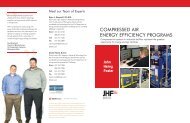The Turbo Air® 3000 Centrifugal Compressor Compressor Handbook
The Turbo Air® 3000 Centrifugal Compressor Compressor Handbook
The Turbo Air® 3000 Centrifugal Compressor Compressor Handbook
You also want an ePaper? Increase the reach of your titles
YUMPU automatically turns print PDFs into web optimized ePapers that Google loves.
<strong>The</strong> <strong>Turbo</strong> Air <strong>3000</strong> <strong>Centrifugal</strong> <strong>Compressor</strong> Operator’s Manual<br />
<strong>The</strong> Installation Work Schedule<br />
Before beginning the actual compressor installation process, the installer should review this Installation<br />
Work Schedule for an overview of the various considerations and procedures involved. Each aspect of<br />
the installation listed in this schedule is fully described in subsequent text and/or Section Two, <strong>Compressor</strong><br />
Specifications.<br />
Before delivery, review all technical documents provided, including the Installation Manual and all<br />
relevant specifications and drawings supplied separately.<br />
1. Select a well-suited location in accordance with the minimum recommended space requirements<br />
for the compressor and future maintenance.<br />
2. Review the list of parts, supplies, tools, and labor that the owner must supply at installation, and<br />
arrange for them all to be readily available on site.<br />
3. Be sure that all required preparations and provisions have been made with regard to the foundation,<br />
piping, and electrical connections, or (if necessary) arrange for suitable storage for the compressor<br />
until the time of installation.<br />
4. At least two weeks before the projected initial startup date, contact a Cooper <strong>Turbo</strong>compressor<br />
representative to schedule startup assistance.<br />
5. Upon its arrival, inspect the compressor and check loose-shipped equipment against the packing<br />
list; if any damage or shortage is noted, immediately report it to the carrier.<br />
6. Set the compressor on the foundation or (if required) put it into storage until the installation may<br />
be completed.<br />
7. After it is in place, secure the compressor on the foundation bolts.<br />
8. Install the external air piping. *<br />
9. Fabricate a manifold to connect the intercoolers and the oil cooler. *<br />
10. Install all piping between the compressor and the main coolant lines.<br />
11. Fabricate the condensate drain pipes and control devices. *<br />
12. Connect the instrument air line to the reservoir vent ejector system.<br />
13. Make all electrical connections.<br />
14. Check the site a final time for conformance to all applicable codes, all relevant recommendations,<br />
and for overall cleanliness and tidiness.<br />
* Certain packaging options involving various piping configurations are available through Cooper<br />
<strong>Turbo</strong>compressor. When included from the factory, considerable savings can be realized at<br />
installation. Details of these options are included later in this manual.<br />
A—4



